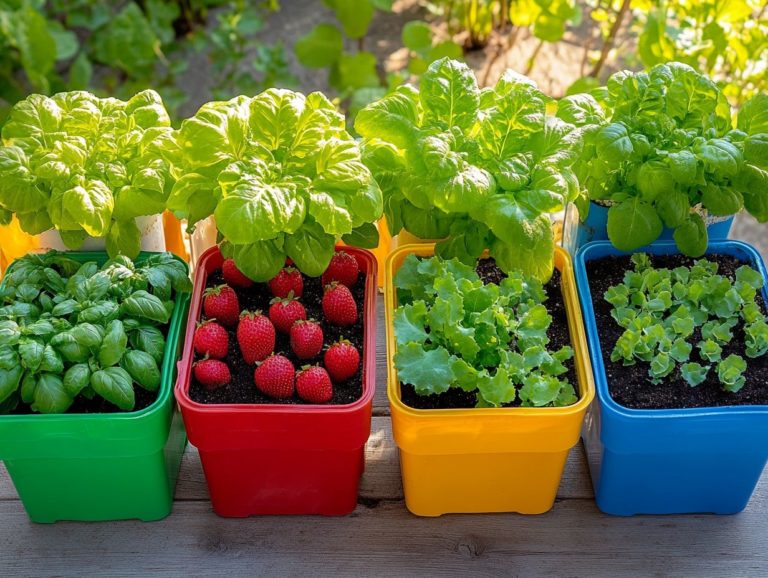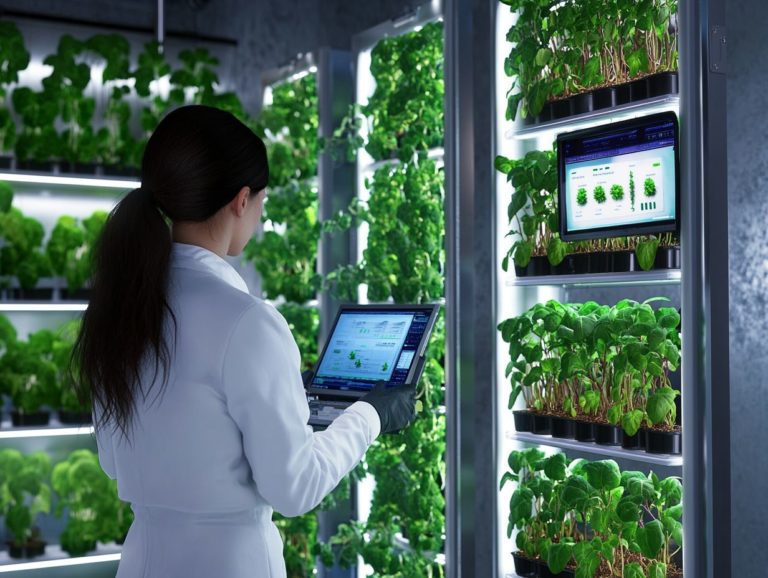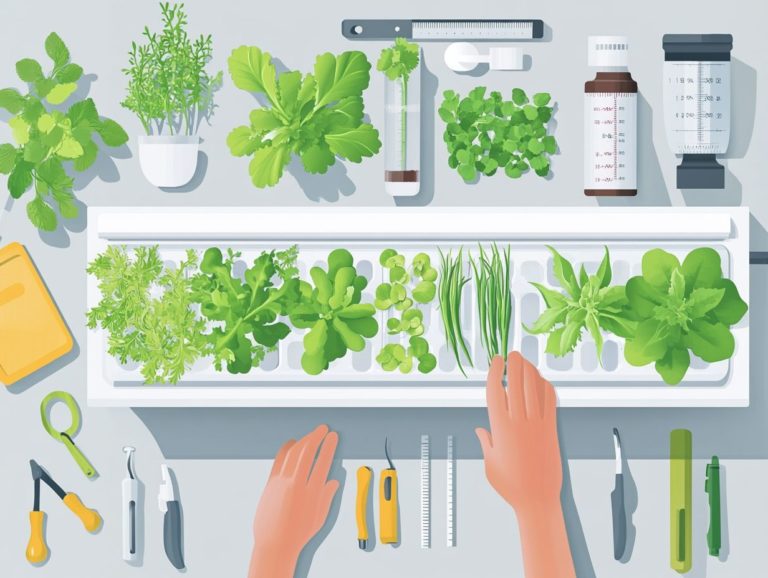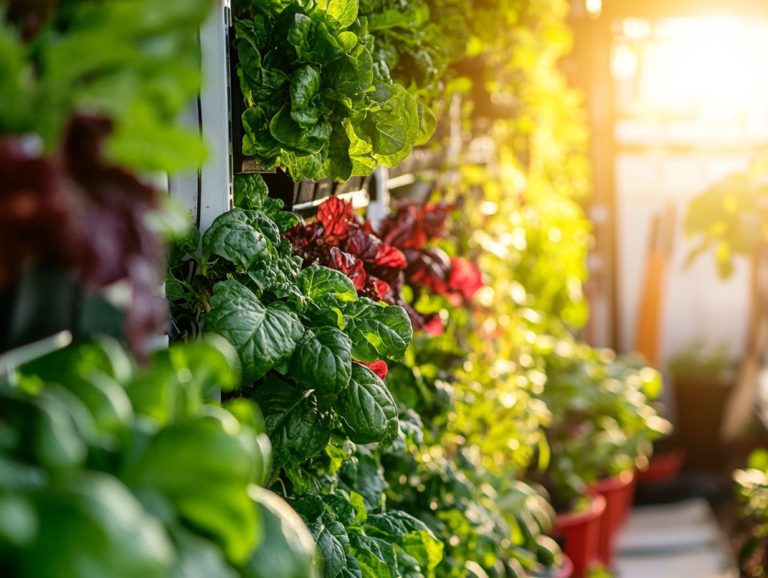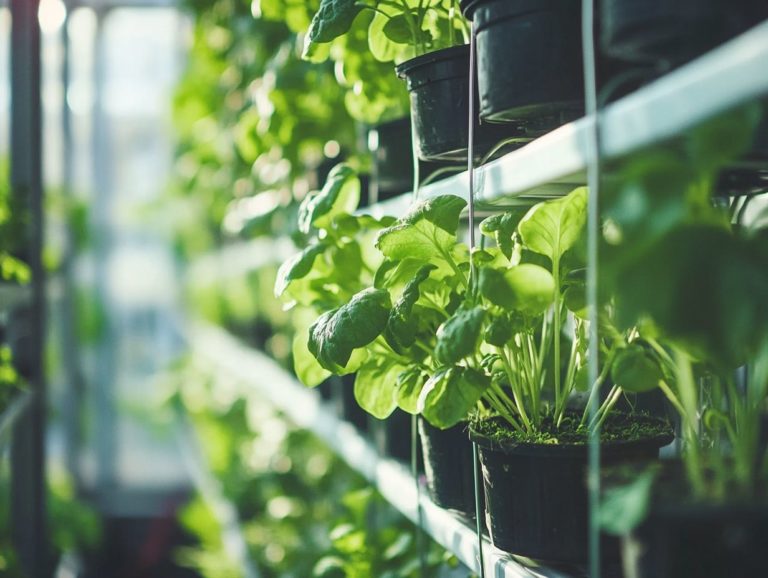What is the Impact of Hydroponics on the Environment?
Hydroponics is transforming the way we cultivate food. It provides groundbreaking solutions to longstanding agricultural challenges.
This article explores the core principles of hydroponics. It highlights its environmental benefits and numerous advantages.
Hydroponics conserves water and minimizes chemical usage. It has the potential to reshape modern farming.
Contents
- Key Takeaways:
- Understanding Hydroponics
- Environmental Impact of Hydroponics
- Benefits of Hydroponics for the Environment
- Challenges and Solutions for Sustainable Hydroponics
- Future Prospects for Hydroponics and the Environment
- Frequently Asked Questions
- How does hydroponics protect our planet?
- Hydroponics uses significantly less water than traditional farming.
- Does hydroponics have any negative effects on the environment?
- What is the impact of hydroponics on air quality?
- Does hydroponics contribute to climate change?
- How does hydroponics impact the use of pesticides and herbicides?
- What is the overall environmental impact of hydroponics?
Key Takeaways:
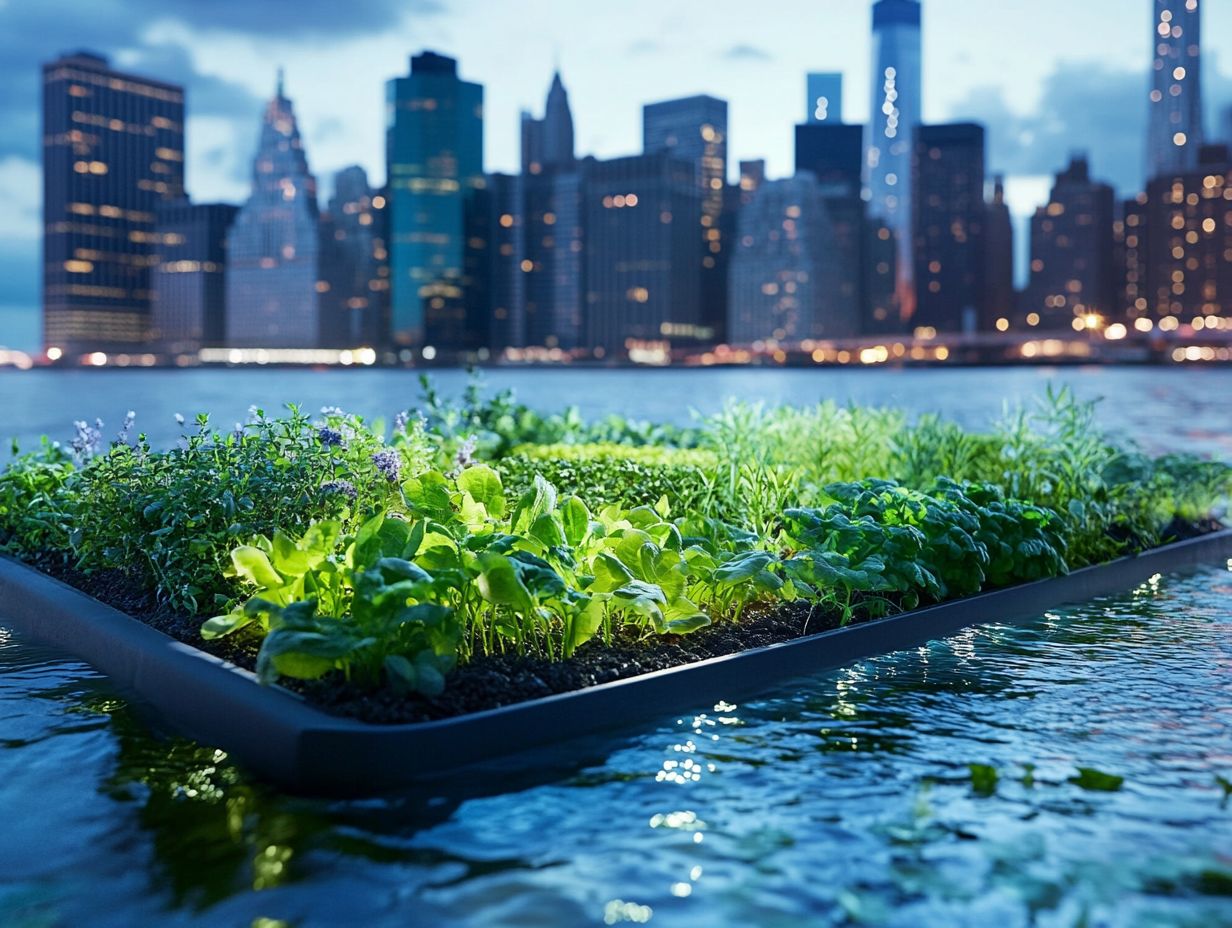
- Discover how hydroponics cuts down water use and champions conservation.
- Learn how going soil-free opens up land for farming.
- Explore how hydroponics is paving the way for a sustainable future.
Understanding Hydroponics
Hydroponic farming is a modern way of farming that enables you to grow plants without soil (the earth where plants usually grow), relying instead on nutrient-rich water solutions. This technique appears in various forms, including greenhouse hydroponics and vertical hydroponics, and has gained significant traction in regions like California and Europe, promoting sustainable agricultural practices.
Influential figures such as Dr. Nate Storey, alongside prestigious institutions like Cornell University and organizations like the World Wildlife Fund, have been instrumental in researching hydroponics as a compelling alternative to traditional farming methods especially in urban settings where space constraints are a reality.
Definition and Basic Principles
Hydroponic farming is all about growing plants without soil, immersing their roots in nutrient-rich water for optimal nutrient absorption and accelerated growth. This innovative agricultural method streamlines nutrient delivery and allows you to cultivate a wide array of crops, from crisp leafy greens to luscious fruits.
By relying on water and minerals, you significantly alleviate issues like soil erosion and pests that plague conventional agriculture. With the power to control every facet of the growth environment light, temperature, and moisture you can achieve higher nutrient content in your crops while using less land and water compared to traditional methods. It s no wonder so many growers are embracing hydroponics to elevate their agricultural practices and promote sustainable food production.
Environmental Impact of Hydroponics
The environmental impact of hydroponics is remarkable, especially when considering its water usage and food waste compared to conventional agriculture, which often leads to resource depletion. This highlights the importance of evaluating agricultural practices.
Embracing hydroponics not only optimizes resource efficiency but also paves the way for a more sustainable future in food production.
Water Usage and Conservation
Hydroponic farming significantly reduces water usage compared to conventional agriculture, cutting consumption by up to 90% while championing effective water conservation practices. This remarkable efficiency comes from the ability to recycle water within a closed system, allowing you to provide plants with exactly what they need.
Unlike traditional farming, where much water evaporates or is lost through runoff, hydroponics delivers nutrients directly to plant roots in a controlled manner. This level of precision conserves water and boosts nutrient uptake, leading to faster growth rates.
Integrating renewable energy sources like solar and wind power into urban hydroponic systems presents exciting possibilities. These energy sources can sustainably provide the necessary power while minimizing environmental impact, making hydroponics an even more attractive option for city dwellers in search of innovative agricultural solutions.
Chemical Usage and Pollution
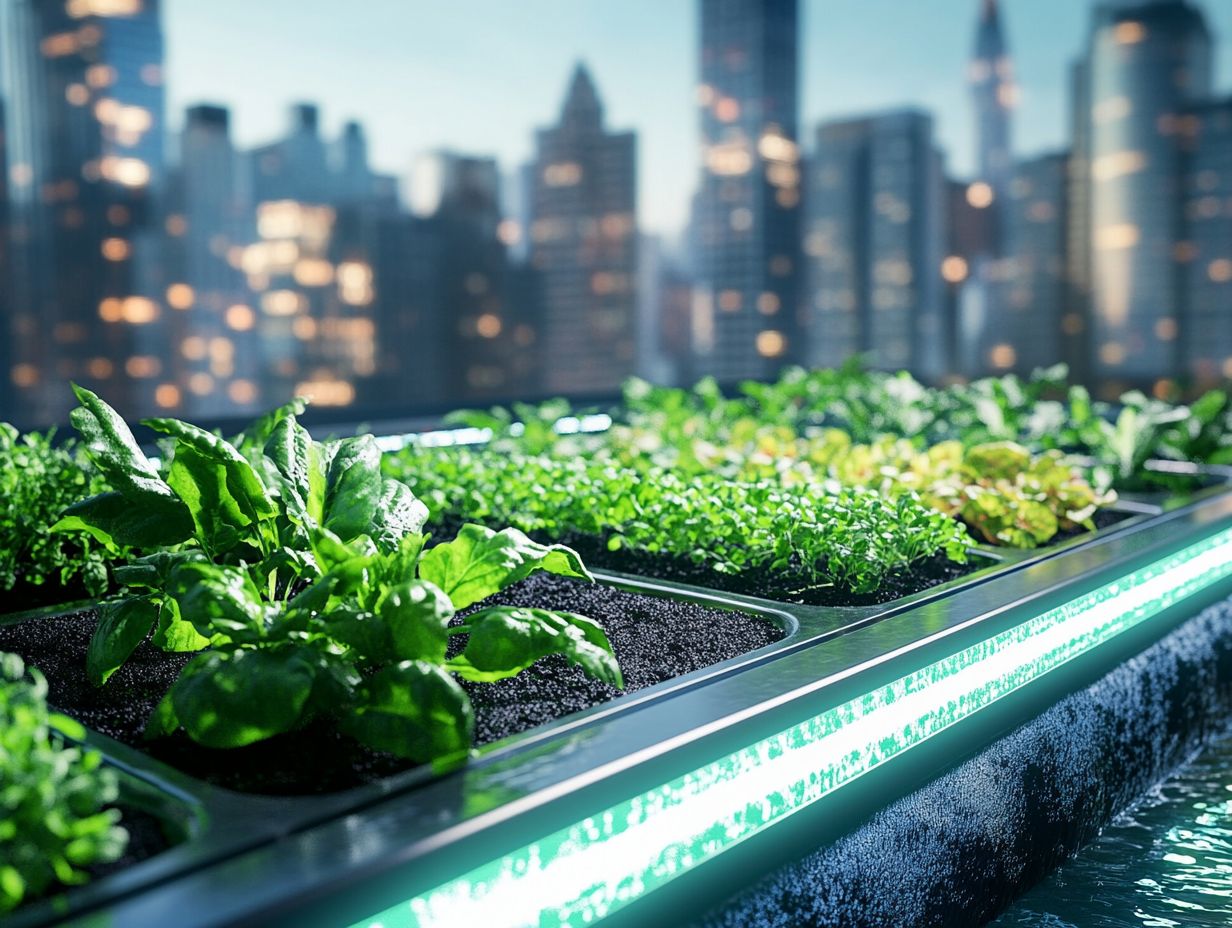
One of the key advantages of hydroponics is its controlled use of chemicals. This allows you to minimize pollution while optimizing nutrient delivery, particularly nitrogen and phosphorus, essential for plant growth within a controlled environment.
Unlike conventional farming practices that often lead to excessive runoff of fertilizers into waterways, hydroponics operates within a closed-loop system (a method where water and nutrients are reused, minimizing waste). This approach enhances nutrient efficiency and significantly reduces the risk of soil degradation and harmful algae blooms.
By employing precise nutrient management techniques, you can control the concentration and timing of chemical applications. This ensures that your plants receive exactly what they need for optimum health.
As a result, hydroponics represents a significant shift toward sustainable agriculture, prioritizing both productivity and environmental stewardship.
Land and Space Requirements
Hydroponics requires significantly less land than conventional agriculture. This makes it an ideal solution for urban environments where space is at a premium, especially in vertical hydroponics setups that capitalize on innovative techniques.
By using innovative techniques that enable plants to flourish without soil, this method boosts production, delivering fresh produce right in the heart of cities.
Urban agriculture initiatives are transforming rooftops and vacant lots into vibrant gardens, significantly enhancing food production potential.
Projects like Brooklyn Grange and Gotham Greens demonstrate how hydroponic systems yield an impressive amount of greens per square foot. The efficiency of these systems addresses land scarcity and reduces the carbon footprint associated with transporting food from rural to urban areas, paving the way for a more sustainable future.
Benefits of Hydroponics for the Environment
Hydroponics presents a wealth of advantages for the environment. Notably, it helps to reduce water consumption, minimize the need for chemical inputs, and enhance land efficiency all crucial factors in tackling the challenges of an ever-growing population facing issues like COVID-19 and climate change.
Reducing Water and Chemical Usage
By employing efficient nutrient delivery systems, hydroponic farming significantly cuts down on both water and chemical usage. This presents a more sustainable alternative to traditional farming methods, a key aspect of environmental sustainability.
This innovative approach utilizes closed-loop systems (a method where water and nutrients are reused) to recirculate water and nutrients, enabling you to exercise precise control over what your plants absorb.
Unlike conventional agriculture, which often relies on excessive amounts of water and fertilizers that can seep into surrounding ecosystems, hydroponics minimizes runoff and maximizes resource efficiency. Such precision mitigates environmental impact and optimizes yields in smaller spaces, positioning hydroponics as a vital solution for urban farming.
As the world faces climate change and food scarcity, embracing these techniques can be instrumental in conserving essential natural resources while securing food for future generations.
Maximizing Land and Space Efficiency
Vertical hydroponics showcases your ability to maximize land efficiency. This technique enables impressive plant yields in limited spaces, effectively tackling urban food production challenges and crucially solving food scarcity.
This cutting-edge farming technique employs stacked layers of crops, eliminating the reliance on traditional soil while delivering nutrient-rich water directly to the plant roots.
In urban environments, where every inch counts, such techniques guarantee the availability of fresh produce while promoting sustainability by minimizing food miles.
Take New York City, for example. A successful project there demonstrated that vertical farms could yield over 100,000 pounds of greens annually from just 30,000 square feet. These systems inherently tackle food waste by facilitating localized production, ensuring that excess food doesn t require long-distance transport before reaching you, the consumer.
Challenges and Solutions for Sustainable Hydroponics
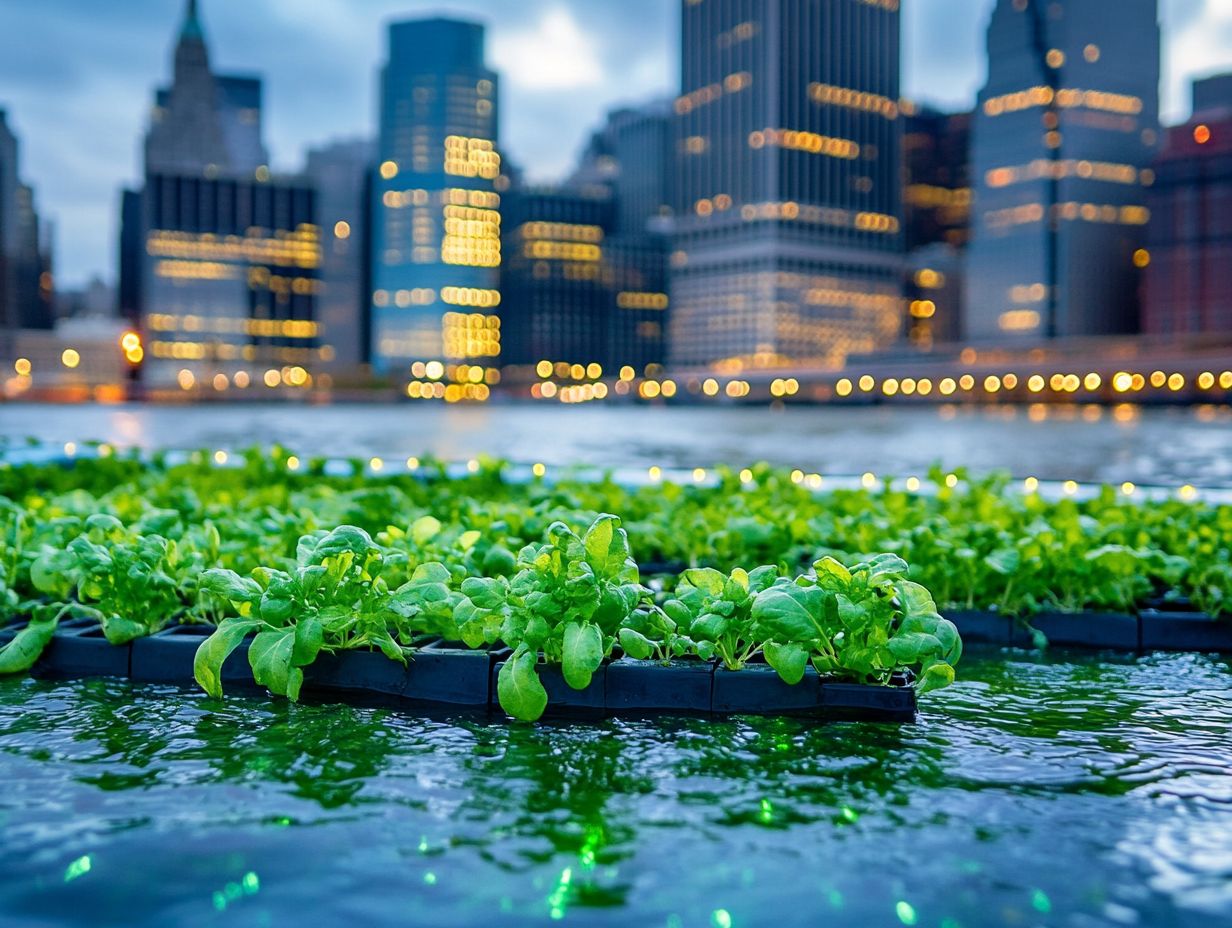
While hydroponics offers a compelling avenue for sustainable agriculture, several challenges arise, including energy consumption and climate control. Addressing these issues is essential to enhance its viability.
Energy consumption and climate control are among the key factors that require your attention as you explore this innovative method.
Addressing Environmental Concerns
To tackle environmental concerns linked to hydroponics, it’s crucial to integrate sustainable technologies. Consider using renewable energy sources, like solar and wind energy, to minimize the ecological footprint of these systems.
You should embrace energy-efficient systems to significantly reduce energy consumption while maximizing plant growth. Innovations such as LED grow lights and automated irrigation systems enable precise monitoring and control of water and nutrients, ensuring optimal conditions for your plants.
Incorporating renewable energy sources, such as solar panels or wind turbines, empowers you to operate sustainably and significantly decreases reliance on fossil fuels.
Adopting these technologies not only promotes a responsible approach to agriculture but also helps mitigate the adverse effects often associated with traditional farming practices, such as soil degradation and excessive water usage.
Implementing Sustainable Practices
Implementing sustainable practices in hydroponic farming is essential for your long-term success while minimizing environmental impacts!
By focusing on recycling nutrient solutions, you can significantly cut down on waste, creating a closed-loop system that conserves valuable resources.
Optimize your energy usage with advanced technologies think LED grow lights and solar panels to further shrink the carbon footprint of your operations.
Instead of relying solely on chemical fertilizers, consider utilizing organic nutrient sources and monitoring pH levels diligently to enhance plant health and resilience. This approach can lead to better yields and a more robust crop.
Integrating these methods will boost your efficiency and positively contribute to environmental sustainability. This commitment will attract eco-conscious consumers who appreciate responsible agricultural practices!
Future Prospects for Hydroponics and the Environment
The future of hydroponics is bright, and now is the time to get involved! With advancements in technology and ongoing research, enhanced food production is becoming increasingly feasible especially in urban environments where demand is soaring.
Potential for Growth and Development
The growth potential of hydroponics is remarkable, especially as urban areas seek innovative solutions to address their food production challenges while embracing sustainable agricultural practices.
As cities grow denser and arable land dwindles, hydroponics stands out as a practical choice for cultivating fresh produce on rooftops, in vacant lots, and within controlled environments. This method optimizes available space, conserves water, and eliminates the need for harmful pesticides.
For example, initiatives in New York City and Singapore showcase how vertical farms can thrive, delivering fresh vegetables directly to local consumers.
When commercial developments incorporate hydroponic systems, they can significantly lower transportation costs and emissions, contributing to a greener urban landscape. The adaptability of hydroponics positions it as a vital element in the future of urban agriculture, promising enhanced food sovereignty and environmental resilience.
Frequently Asked Questions
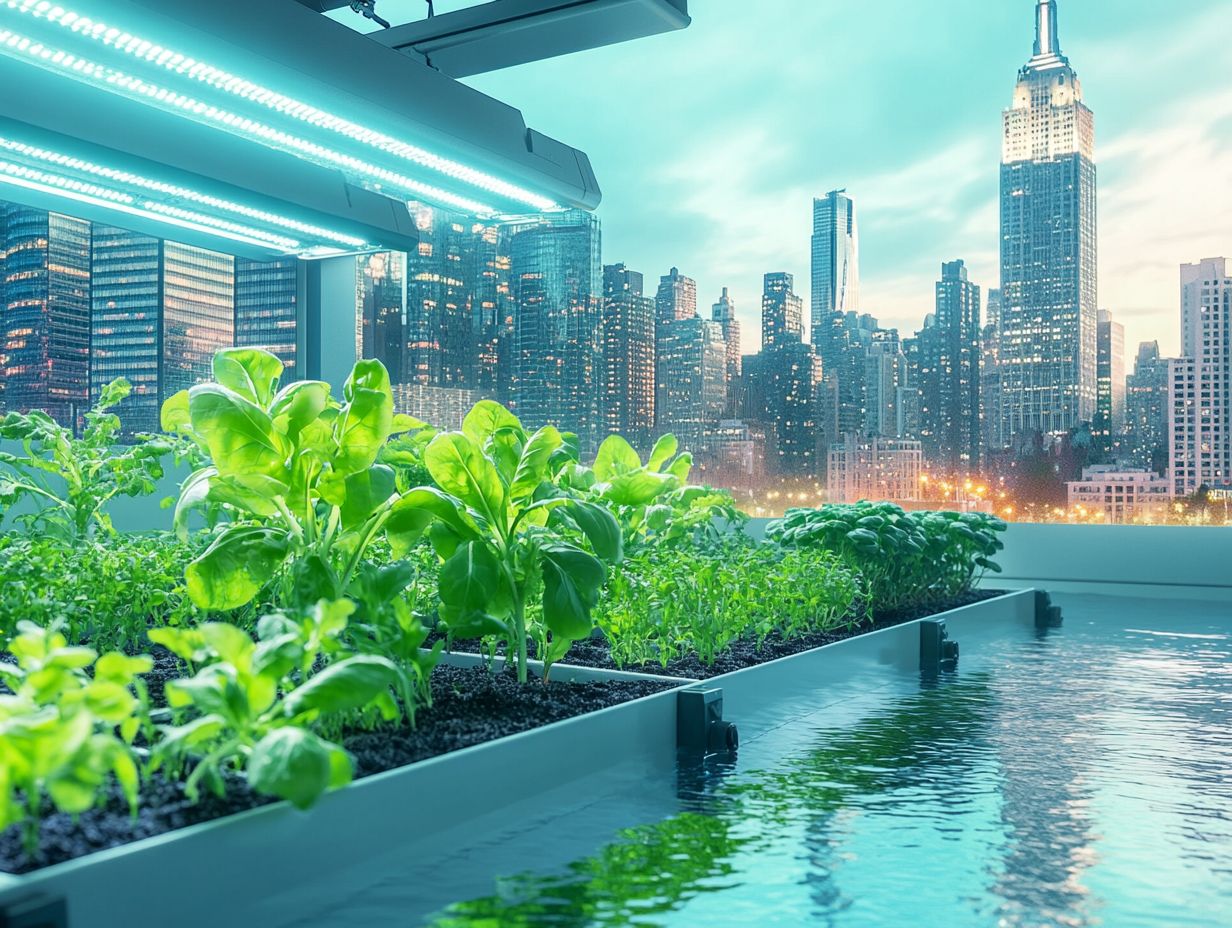
How does hydroponics protect our planet?
Hydroponics is a method of growing plants in water without soil, using nutrients instead. This has sparked interest in its impact on the environment. Let’s explore some frequently asked questions about the topic.
Join the movement toward sustainable agriculture today! Discover how you can make a difference.
Hydroponics uses significantly less water than traditional farming.
It recirculates and reuses water, reducing waste.
Does hydroponics have any negative effects on the environment?
Hydroponics reduces nutrient runoff and soil erosion compared to traditional farming.
However, plastic materials used in hydroponic systems can harm the environment if not disposed of correctly.
What is the impact of hydroponics on air quality?
Hydroponics can increase oxygen production in plants compared to soil growth.
This improvement can enhance air quality and reduce the need for deforestation.
Does hydroponics contribute to climate change?
Hydroponics allows year-round growth in controlled environments.
This reduces transportation needs for produce, cutting down on carbon emissions.
How does hydroponics impact the use of pesticides and herbicides?
Hydroponic systems are often closed and can be indoors, minimizing the need for pesticides and herbicides.
Without soil, pests and weeds struggle to thrive, further reducing chemical use.
What is the overall environmental impact of hydroponics?
Hydroponics can significantly lower the environmental impact of traditional farming.
It uses less water and land, produces less waste, and can enhance air quality.
However, responsible disposal of materials in hydroponic systems is vital to minimize harm.

